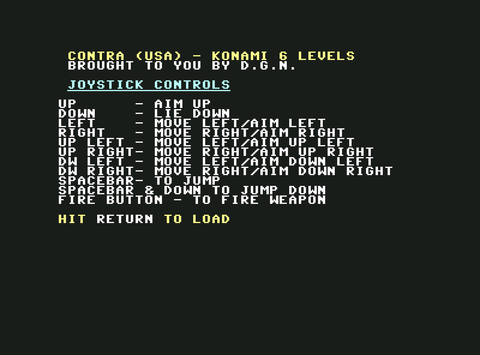Run, Shoot, and Compare the Computer Ports for Contra
Experiencing all the computer ports of Contra gives the audience the literal notion of masochism, and in this article, we inspect the important reasons behind this fact, by introducing the Arcade version first, and comparing these ports with the original title.
CONTROLS
The original Arcade game utilizes automatic movement in the air, and this means that while you’re holding the right direction, for example, and hit the jump button to move in the air, the character goes to the right automatically, even if you released the desired direction during the process. But you cannot shoot upward and downward while moving along the x-axis in the air; as pressing up and down directions, in the same position, makes your character stop along the said axis. An automatic movement in the air doesn’t necessarily mean that you cannot change your direction after each jump.
The game sometimes doesn’t detect the lowest platform on the screen, as descending through the lowest one can make your character die:

But the Amstrad CPC port is different; you have one button to fire, an up direction to jump, and a down direction to drop down to lower platforms, meaning that the whole control scheme is made up of the main directions, plus one button to action. Holding this button will result in shooting, with all the weapons acting like machine guns in the game. So, you cannot crouch, until you’re shooting, and you cannot jump, while you’re shooting! Also, there is no way to fire downward, the lowest platform detection remains the same, and the automatic movement in the air is dropped.
The ZX Spectrum one is weird, making it a unique title compared to the other conversions; automatic movement in the air made a return, but there is no stopping the character; the scrolling seems working, but you’re not able to go to the left; every other thing seems fine, but there is no shooting downwardly. Also, the ability to change your direction after each jump in the air, is only present in the tunnel levels, with no diagonal shooting in its boss fights. And here’s the worst part; if you jumped, the game pulls the last standing position, and is forcing you to aim only at that angle in the air, without any option to change so, until you hit the ground and repeat the process with another jump!
The Commodore 64 is not official, but rather a romhack. It's still being included because it is well done, and Commodore 64 is awesome. It inherited its own issues and limitations for controls: no shooting downward, no automatic movement in the air and no lowest-platform detection. However, all the weapons act like machine guns, and no problem can be experienced with diagonal shooting in the game, but for some reason, the jump button (space bar) doesn’t function normally, and you have to tap it multiple times to make it work! Not to mention that the fire button means JOYSTICK, and the jump button means KEYBOARD:

The MSX2 title, has the nearest controls to the Arcade game, as you have the ability to fire downwardly from the air. However, the automatic movement in the air is gone, with the jumps pulling the sensitivity of the button you’re pushing, with no shooting left-upwardly.
And even this port doesn’t solve the lowest-platform detection problem.
GAMEPLAY
The Arcade version is your typical Contra; a variety of arsenal with pseudo-3D levels, and technical achievement, with visually impressive features. You have 3 continues, even if you have hundreds of coins, and you’ll get killed if you dive into your enemies. Also, the game uses some methods to make one of the oldest examples of level design with just two buttons, where an obstacle fixes the player’s position in the last level:

The original title gives the player an opportunity to ignore a few mini-bosses in the game, creating opportunities to fool them:

And about the Amstrad CPC port; the R power-up is replaced with a machine gun, no continues across your journey, and the scrolling effect is not smooth as well:

And what’s the problem with the scrolling effect the game has? Well, the bullets of your enemies, for example, can go through sections of a level, but a weapon, as the power-ups of the game, disappears when the screen gets scrolled.
In the ZX Spectrum port, there is no design for the power-ups that you’ll get; you hit their cases, and you get the weapons, and losing your lives doesn’t mean losing your arsenal. However, the game is still hard, since you’ve got no way to increase your lives through your progress (with no continues), and the scrolling effect creates big problems in the waterfall level (with bad enemy placement):

But thankfully there are some tricks for the final bosses, as they don’t react to you while not being revealed completely:

The ability to fool bosses in the Commodore 64 conversion, to an extreme degree, is its ridiculous gameplay feature, as this boss is ignorable, and you can scroll through the level with no threat ahead:

The opportunity to play with unlimited lives, WITHOUT any cheat codes, is the main benefit you could get from this version, as the game asks so from the player:

The MSX2 port, feels a lot like a bootleg version, as the enemies seem to come from another world:

While the weapons came from another universe:

As you have to aim in the worst ways ever in your gaming life:

And you must go through nearly 20 stages, to put an end to this expedition!
The scrolling effect is a lot like the Amstrad CPC port:

And the whole game feels like an RPG version of Contra:

While it’s the first time that you have a health bar for each of your lives.
VISUALS
The original Arcade title is a technical achievement for its era: more than just one design for weapons’ looks, and different kick-back effects with a great game-feel:

The game also uses parallax scrolling, with parts of the background moving at a different speed than parts of the foreground:

The Amstrad CPC port seems like a demake version; no different design for the weapons’ looks, and no different kick-back effects, like the Arcade game. And the main problem is that the color of your bullets is the same as that of your enemies, so you don’t know when to crouch. The ZX Spectrum port has the same problem, plus the fact that the color of your bullets can be the same as the whole environment:

There is nothing special about the Commodore 64 conversion, as it’s like a demake version of the Amstrad CPC title. Compared to the Amstrad CPC port, the color of bullets is clearly distinctive, and compared to the ZX Spectrum port, every object has its own visual identity.
The MSX2 version is more colorful than the Commodore 64 port, and unlike the CPC one, is the closest conversion to the original game with its great color palette. However, since it’s like a bootleg version of the original game, you can sometimes see the character changing its color scheme from stage to stage, with no logical reason!
UNIQUE FEATURES
If you wait for minutes in the Arcade game, you’ll see some objects diving into the character and enemies appearing, to punish the player for waiting for too long:

The Arcade version also, looks more realistic than the other ones, because if you want to start shooting diagonally, the character shoots some bullets, somewhere between your main angle and the desired direction, till he reaches the desired diagonal direction you want:

As a sad conclusion of your ultimate efforts, the Amstrad CPC port has a dark message at the end of the game:

The unique feature of the ZX Spectrum title though, is its main menu, providing the player with a variety of options, as you can see:

In the Commodore 64 one, you can complete the game with unlimited lives, as said above in the Gameplay section.
And, the ending of the MSX2 version is its reward for your hard attempt:




